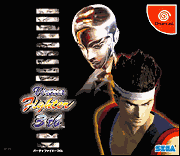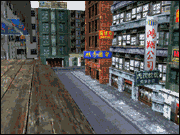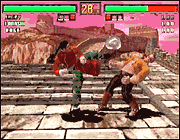

VIRTUA FIGHTER 3tb
Copyright © Sega Enterprises, Ltd., 1997, 1998
Sega Dreamcast
3D Fighting game
1~2 Players
Arcade Stick compatible
VGA box compatible
HDR-0002
¥5800
Available in Japan
Where to buy
—by Geir Friestad




|
 |

Sega's VIRTUA FIGHTER saw the light of day in December 1993,
and immediately carved itself into the great stone slabs of history as the very
first 3D-based
fighting game. Not only that, but VIRTUA FIGHTER also set a new standard and
raised the bar considerably for other fighting games to follow. Many tried to
copy the success of Sega's new baby, but the magic more often than not slipped
through the competitors' fingers and left them with embarrassing and shallow
VF-clones on their hands. Meanwhile, Sega continued to taunt the competition
with new and remarkably improved sequels to VIRTUA FIGHTER.
 The second sequel, VIRTUA FIGHTER 3, was released in September 1996, and was a
huge success in Japan, if not in the rest of the world. A little while later, a
reworked "tag team battle"-version, dubbed VIRTUA FIGHTER 3TB, "tb" referring
to "team battle," was released. The second sequel, VIRTUA FIGHTER 3, was released in September 1996, and was a
huge success in Japan, if not in the rest of the world. A little while later, a
reworked "tag team battle"-version, dubbed VIRTUA FIGHTER 3TB, "tb" referring
to "team battle," was released.
 Being one of Sega's key arcade titles, there was never much of a question
whether VIRTUA FIGHTER 3 would be one of the first titles to hit Sega's new
console or not, despite the game's weak status outside of Japan. The job of
porting the Model 3-based game was handed over to developer Genki, with a
tight deadline firmly attached. The end result is a near arcade-perfect, but
also very obviously rushed and regrettably sparse console fighting game. Being one of Sega's key arcade titles, there was never much of a question
whether VIRTUA FIGHTER 3 would be one of the first titles to hit Sega's new
console or not, despite the game's weak status outside of Japan. The job of
porting the Model 3-based game was handed over to developer Genki, with a
tight deadline firmly attached. The end result is a near arcade-perfect, but
also very obviously rushed and regrettably sparse console fighting game.
 Everything you saw in the arcade version, give or take a few minor details,
is included in Dreamcast VF3. The game runs at a smooth and steady 60Hz. The
graphics are stunning; the characters are huge and detailed, with gorgeous
textures to boot. The backgrounds are all 3D, like in the arcade. The audio is
still unremarkable, with music as bland as water and somewhat flat sound
effects to color the on-screen martial moves. But more importantly, all the
moves and devious combos you spent truckloads of time and money on perfecting
in the arcade version still work flawlessly. Everything you saw in the arcade version, give or take a few minor details,
is included in Dreamcast VF3. The game runs at a smooth and steady 60Hz. The
graphics are stunning; the characters are huge and detailed, with gorgeous
textures to boot. The backgrounds are all 3D, like in the arcade. The audio is
still unremarkable, with music as bland as water and somewhat flat sound
effects to color the on-screen martial moves. But more importantly, all the
moves and devious combos you spent truckloads of time and money on perfecting
in the arcade version still work flawlessly.
 So what is wrong with this picture? The Dreamcast-port has everything the
arcade version had, so what can possibly be wrong? So what is wrong with this picture? The Dreamcast-port has everything the
arcade version had, so what can possibly be wrong?
 It's simple. We're used to console versions of arcade-ported fighting games
being everything the original was and more. For starters, the Dreamcast version
of VIRTUA FIGHTER 3TB lacks a decent training mode. What you get is basically
just a regular fight, with the joypad-output displayed over the screen action.
This is pretty pathetic compared to the excellent training modes in DEAD OR
ALIVE and, in particular, TEKKEN 3. It's simple. We're used to console versions of arcade-ported fighting games
being everything the original was and more. For starters, the Dreamcast version
of VIRTUA FIGHTER 3TB lacks a decent training mode. What you get is basically
just a regular fight, with the joypad-output displayed over the screen action.
This is pretty pathetic compared to the excellent training modes in DEAD OR
ALIVE and, in particular, TEKKEN 3.
 Players are also used to being rewarded with some kind of
FMV-based ending for our favorite characters when
completing fighting games. There is such a beast in VF3,
but there's only one movie for all the characters, and you have to access
it manually from another menu after finishing the game. Make sure to save your
high scores—again manually; no auto-saving here—before you watch it
though, because the movie will loop until you stop it by resetting your
Dreamcast. Players are also used to being rewarded with some kind of
FMV-based ending for our favorite characters when
completing fighting games. There is such a beast in VF3,
but there's only one movie for all the characters, and you have to access
it manually from another menu after finishing the game. Make sure to save your
high scores—again manually; no auto-saving here—before you watch it
though, because the movie will loop until you stop it by resetting your
Dreamcast.
 The biggest problem with this port of VF3 is,
however, the omission of a real
versus mode. Whether it was due to lack or time or just an act of plain
weirdness by the people at Genki is not known, but it really doesn't matter. It
doesn't change the fact that the versus mode simply isn't there, and that you,
in order to duke it out on-screen with a friend or foe, have to start a normal
game versus the CPU and have your opponent challenge you, just like in the
arcade. It can be argued that this is more true to the arcade version, but that
is still a poor excuse. The challenge method is time consuming and restrictive,
as only the looser is able to switch characters between bouts, and it's easy
to tire of it. The biggest problem with this port of VF3 is,
however, the omission of a real
versus mode. Whether it was due to lack or time or just an act of plain
weirdness by the people at Genki is not known, but it really doesn't matter. It
doesn't change the fact that the versus mode simply isn't there, and that you,
in order to duke it out on-screen with a friend or foe, have to start a normal
game versus the CPU and have your opponent challenge you, just like in the
arcade. It can be argued that this is more true to the arcade version, but that
is still a poor excuse. The challenge method is time consuming and restrictive,
as only the looser is able to switch characters between bouts, and it's easy
to tire of it.
 In the end, it's still impossible to put down VIRTUA
FIGHTER 3TB as a bad game,
or even a bad port, however. The gameplay was already rock solid from the
beginning, and Genki admittedly had painfully little time (six months) to learn
how to program new hardware and port an important title. Add to this the fact
that many of the Dreamcast's launch titles were pushed back, forcing Sega to
release VF3TB as a launch title, which shaved off even more of Genki's deadline,
and the result is pretty impressive after all. In the end, it's still impossible to put down VIRTUA
FIGHTER 3TB as a bad game,
or even a bad port, however. The gameplay was already rock solid from the
beginning, and Genki admittedly had painfully little time (six months) to learn
how to program new hardware and port an important title. Add to this the fact
that many of the Dreamcast's launch titles were pushed back, forcing Sega to
release VF3TB as a launch title, which shaved off even more of Genki's deadline,
and the result is pretty impressive after all.
 Dreamcast-owners pondering embarking on a long fighting game career on their
new NEC-powered magic machine should seriously consider investing in Sega's
Arcade Sticks, though, as the standard Dreamcast pad is not well suited for
fighting games. And with such tempting titles as Tecmo's DEAD OR ALIVE 2 and
Capcom's POWERSTONE looming on the horizon, it may not turn out to be a bad
investment after all. Dreamcast-owners pondering embarking on a long fighting game career on their
new NEC-powered magic machine should seriously consider investing in Sega's
Arcade Sticks, though, as the standard Dreamcast pad is not well suited for
fighting games. And with such tempting titles as Tecmo's DEAD OR ALIVE 2 and
Capcom's POWERSTONE looming on the horizon, it may not turn out to be a bad
investment after all. 
Rating: *** out of 4 |

